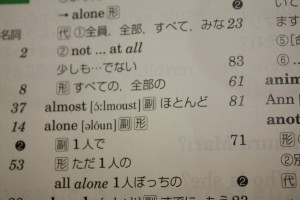PRESENTATION: Children’s English Education @ Happonmatsu Shimin Centre
I did a presentation today for parents (mothers) of young children today on the topic of English education for children. The presentation was in Japanese, and I had a lovely group of people who seemed interested and asked good questions.
Here are my slides, cryptic as ever: 160706 Children Learning English
The questions at the end were submitted by participants prior to the event, which was a really nice touch as it gave me a chance to get my answers ready 🙂
Let me know if anything is unclear in the comments below!
Freestyle warmups for children’s classes
Recently I have been doing these kinds of freestyle warmups with children’s classes. They are easy, fun, interactive, and break up a regular class well.
Start by introducing the language on the board. Then practice orally. Finally have students write their personalized version in their notebooks. The whole thing takes about ten minutes.
Teaching alphabet stroke order and stroke count to Japanese children
Not as clear as it first seemed
I’ve also been meaning to write this post for a while 🙂
A couple of years ago it came to my attention that some of our students were being told by their elementary school teachers and junior high school teachers that they were writing English letters wrong.
After an initial reaction of annoyance (this seems to be a perennial problem with some teachers who don’t have the confidence to deviate from the one correct answer given by the textbook), I decided that it might be better to find out what the official ‘stroke order’ for the alphabet in Japan is and make sure our students know it.
I have done some quick research and there doesn’t seem to be any official stroke order. I found the following two online:
This is from Nintendo
And this is from GakuryokuUp.
As you can see, they are slightly different (lower-case w, for example). Presumably the teachers are going off whatever textbook they are using in class, and are so insecure that they won’t accept alternatives.
Which kind of takes us back to the beginning. I guess we just need to teach our students that there are different ways of writing letters, and some of their teachers in the future are going to be particular about how they are written in their class. Always do things the way your current teacher wants you to, even if they are wrong (like the ALT who told one of our students that the only correct response to ‘how are you?’ is ‘I’m fine, thank you’).
Any experiences with teaching letter-writing?
eikaiwa expectations high school JHS junior high school kids Language learning teaching vocabulary
by sendaiben
14 comments
My ‘almost’ mini-lesson
Unfortunately, many students in Japan are taught that ‘almost’ in English is ‘hotondo’ in Japanese
Sadly this is not true, so over the years I have developed a short mini-lesson to correct this false impression and help students better understand the meaning of almost.
The lesson can start at any time, but it requires a trigger: one of the students must translate almost as hotondo.
Once that happens, I quickly go through the following steps:
- I point out that even though many teachers and textbooks teach this, almost is not the same as hotondo
- I pretend to trip, and then say “phew, I almost fell over just now”
- I ask the students to translate the previous sentence: “hotondo korobimashita” sounds really strange, so clearly hotondo is not a good translation here
- I tell the students I planned to go to Tokyo this morning, but ended up not going. “I almost went to Tokyo”
- “Hotondo Tokyo ni ikimashita” also sounds weird
- I offer two alternative translations for almost: mou chotto de ~ and ~wo suru tokoro datta
- I explain that hotondo is actually almost all in English: mou chotto de zenbu
Of course, this illustrates vividly the perils of learning and teaching vocabulary out of context, which provides another excellent mini-lesson for the students 🙂
Do you have any favourite mini-lessons?
business eikaiwa kids school management study trips summer camp young learners
by sendaiben
leave a comment
Eikaiwa School Field Trips: Summer at the Zoo
Every year we organize some kind of optional summer event for our students. Past events have included ice skating (feels weird to put on sweaters and gloves in August!), outdoor games, playing in a river, and trips to the seaside. This year we decided to go to Yagiyama Zoo in Sendai with our preschool- and elementary school-aged students.
Before the trip we visited the zoo to plan out routes and activities, bought small sketchbooks for all the students, divided them into groups and assigned teachers to lead each group.
There was a slight problem with the timing of the announcement coinciding with the school being closed for some classes, so that some parents only got the announcement letter after the trip was full! We did our best to accommodate them which led to us needing a larger bus and the groups getting a bit too big for the number of teachers we had (several were away due to the summer holidays).
Then the day before the excursion the weather reports changed from sunny with cloudy spells to rain (60%). Then that evening rain (70%). The next morning the ground was wet when we woke up at six am, but by seven it was raining. By eight thirty (the deadline for making a decision) it was raining heavily.
Fortunately we had a plan B. We had made arrangements to go to the aquarium at Matsushima in the event of rain. This was not ideal, but preferable to cancelling and being out of pocket for the bus hire and other expenses.
The problem with the aquarium is that we hadn’t had time to visit and make plans. It was also much more expensive than the zoo, and smaller. We weren’t sure if there was enough to do there for the four hours we had planned.
Lessons Learned
We learned a lot from this year’s trip. Here are some of the most important things:
1. Having a plan B is essential if weather could impact on your trip. What were the chances of the only rainy day for weeks and weeks being the day we were going to the zoo? Because we had a plan B and had told the students and parents about it our trip wasn’t ruined. However, we should have put more time into getting ready for plan B.
2. Accurately estimating demand, making sure the sign-up process is fair to everyone, and sticking to deadlines and limits on numbers of students is important. We didn’t have any major problems this time, but the large numbers of students made things more difficult for our teachers (I found myself supervising sixteen young children for much of the day, and it was too many for comfort).
3. The number of seats quoted by bus companies include those fold-down seats in the middle. I don’t like them because they are uncomfortable, seem less safe, and mean that it is not possible for teachers to move around the bus when they are in use. In the future, I would like to make sure all the students have a proper seat, with only teachers in the middle seats if necessary.
Conclusion
In the end the trip turned out well. The aquarium had just enough to keep us busy (looking at the fish, drawing pictures, watching the sealion show, shaking hands with a sealion, meeting baby turtles, wading in a big pool, etc.). It was also great that they had a large seating area that wasn’t at all busy, so we could sit the students down in groups and talk to them, have them draw pictures, and eat lunch in an orderly fashion.
I think we were both unlucky (the weather) and lucky (everything turned out fine and the students enjoyed themselves). We also got a few insights for next year.
Does anyone else do field trips?






